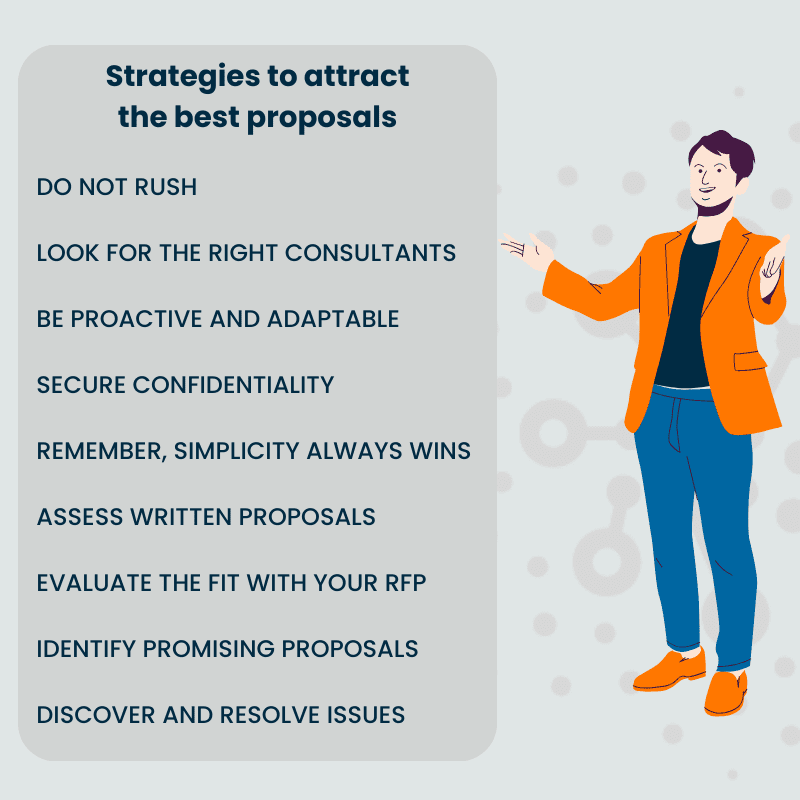Navigating the vast landscape of proposals for consulting services can feel like embarking on a grand quest. You’re not just hunting for a consultant; you’re seeking a partner-in-arms to confront challenges or forge paths into the future.
But every quest has its map, and in the world of consulting, the sourcing process is that guide, ensuring the trail you blaze aligns perfectly with your needs. Now, every seasoned traveler (or in this case, procurement professional) knows the value of a trusty map.
They’re the unsung heroes, diligently working behind the scenes to ensure that the business is equipped with not just any proposal for consulting services, but the winning one.
So, what’s the North Star guiding this quest for the best proposal? It comes down to answering the trio of golden questions:
- Does the consultant get the crux of our challenge?
- Are they equipped to tackle it head-on?
- And, importantly, will our paths align for a successful journey together?
Laying down a well-structured sourcing path is akin to ensuring you have the best gear for your journey. It’s what turns a perilous trek into a smooth sail, bringing forth the most robust proposals for consideration.
And always remember, in the wise words of neuroscientist Sam Harris, “Failing to prepare is, generally speaking, preparing very well to do the wrong thing.” Prepare well, and may your consulting quest yield the treasures you seek.
1. Don’t Rush It
Understanding your needs and articulating your expectations in writing is a key step when sourcing proposals for consulting services. It is also one of the most challenging.
Many RFPs for Consulting are rushed in their development. Sometimes the details or the context are insufficient to understand the business problem you are facing.
Maybe some key requirements are missing, or the language is ambiguous. You also might have omitted the common pricing framework to be followed or given too little time for the candidate consultants to respond to RFI/RFP.
However, the result is always the same: it is difficult for Consulting Firms to send a solid proposal, in particular, if they are newcomers.
The RFP will be the reference document for the consulting providers you invite to the competition. Don’t forget to include elements on the RFP process such as timeline, criteria of choice, and requirements. It will help the candidates to be laser-focused on your needs.
2. Look for the Right Consultants
The universe of consulting is as vast as, well, the universe itself. It’s filled with galaxies of gurus, constellations of connoisseurs, and the occasional black hole of baffling advice.
Navigating this space is crucial because working with the right consultants is like hitching your wagon to a star. Wrong pick, and you might end up in a wormhole leading nowhere.
They’re not commodities, just like stars aren’t all the same. But here’s the silver lining (or should we say, the Milky Way?): proposals for consulting services apart from those unicorns with super niche skills, most consultants aren’t irreplaceable.
So, keep your eyes on the North Star, or better yet, your project’s specific needs.
3. Adapt Your Shortlist to the Project’s Budget and Timeline
Look closely at the project’s scope, the budget, and the internal procurement policies to define your criteria of selection for the short-list. Be mindful of your time and adapt your short-list’s length to the level of priority and the budget of your project.
When you have a very tight timeline or small projects with limited impact on your business, prefer a small short-list to spend enough time on the proposal and the references checking. We recommend not going beyond three prospective providers.
For larger projects, you can broaden the first round (briefing/proposal phase) to up to ten consulting firms (depending on the project and the stakes) but keep at most four-five companies for the final round (pitching phase).
When your short-list is ready, contact your suppliers and check their interest by sending your RFP.
4. Secure Confidentiality
It is important always to protect your confidential information. Don’t hesitate to make your candidates sign a confidentiality agreement at the beginning (even at RFI or RFP stage) to protect proprietary information and make sure the consulting firms will not be sharing your project’s details with your competitors.
If the proposal includes collaboration and sub-contracting, make sure that an NDA legally binds all the project contributors.
If your project is particularly confidential, you should even consider working with a third-party sourcing company, like Consulting Quest, that will handle the process anonymously. They will keep your company and your project confidential until the short-list stage.
5. Remember Simplicity Always Wins
And it’s best to make things simple. Unless you are handling a multi-million dollar project, don’t organize extravagant tenders. Looking through proposals and listening to consultants’ pitches can be extremely time-consuming.
It will also considerably slow down your project. Make sure that your RFP process is adapted to the scope and the budget for your project.
If you only have a small number of consulting firms, or if the project is specifically complex, you might want to organize briefings to discuss the project’s details and make sure the consultants have well-understood what is at stake.
If you have a large number of candidates, a clear RFP, and little time on your hands, you can just send the RFP and assess the written proposals to identify the most promising one for the next step.

6. Assess the Written Proposals for Consulting Services
Once you have received the proposals, take the time to review them with the other stakeholders. Always keep your objective in mind: maximizing the chances of success of your project.
You need the candidates to submit their best proposals, and for that, they need to understand the problem very well.
Level the ground, so all companies have a fair chance in the competition. It is in your best interest to do so too.
Don’t hesitate to explain in length the background of your company and the context of the assignment and to take some time to polish the Q&A documents.
7. Evaluate the Fit with Your RFP
Make sure the candidates have responded to the most important elements in your RFP. Their proposals should help you answer the following questions:
- Has the consultant understood our objectives?
- Do the deliverables answer our questions?
- Do we trust the approach the consulting provider proposes?
- Does the team have the required experience?
- Is this consultant the right fit for you?
- Does the budget fit the value we expect?
Note if there are any gray areas and potential for misunderstanding
8. Identify the Most Promising Proposals for Consulting Services
If consulting proposals were a deck of cards, you’d want to play your hand strategically. With a stack of these in front of you, where do you start? Channel your inner Sherlock and look for clues.
Objectives: Did the proposal echo back to you in the tone of a long-lost friend? Do they seem to “get” your business and the challenges you’re wrestling with?
Deliverables: It’s a bit like ordering a burger and checking if all the toppings you asked for are there. Did they list what you expected, even if it’s wrapped up differently? And are there bonus toppings that pleasantly surprise you?
Approach: Does their methodology resonate with you? Is it like a well-tailored suit – it just fits? And, importantly, does the timeline feel right?
Experience: Do they have the resume to back their claims? Are they the seasoned veterans or the eager rookies of similar projects? And is the team ensemble sounding more like a harmonious orchestra or a garage band?
Fit: It’s like dating. You might be meeting on Zoom, but can you picture long brainstorming sessions with them over coffee (or tea, if that’s your jam)? Do they vibe with you?
Budget: Goldilocks had her porridge dilemma, and you have your budget. Is their price too hot, too cold, or just right?
9. Discover and Resolve Any Uncertainties
Proposals can be like first drafts. Occasionally spot on, but often they need a bit of refining. Think of the initial proposal as clay, with you and the consultant sculpting it into the masterpiece it can be. Identify the strengths – those are your pillars.
But don’t shy away from the weak spots. Bring them to light, challenge the consultants, and invite them to pitch.
Sure, in this era, that might be over Zoom, where ties are optional, and cats wandering in the background are the norm.
But it’s an opportunity to see if you gel with them. Because at the end of the day, the chemistry has to be right. After all, you’re not just hiring a service; you’re forming a team.
Conclusion – Nailing the Consulting Proposal Tango
Cracking the code to obtaining the best consulting proposals is akin to mastering a sophisticated dance – it’s an art as much as it is a science. Like any dance, it demands time, energy, and a bit of finesse.
Expertise and a structured process? Those are your rhythm and beat. Without them, you’re merely shuffling on the dance floor. But the real magic lies in the communication – the subtle glances, gestures, and moves that convey your desires and intentions.
You can’t expect your consulting dance partner to anticipate every step (even if their LinkedIn endorses them as ‘mind-readers’). If you’re vague, you inadvertently roll out a red carpet for those consultants who’ve danced with you before, as they’re attuned to your unique moves.
Remember, consultants, with their Sherlockian observation skills, often decipher both the spoken and the tacit. It’s their survival toolkit, honed from navigating countless boardrooms and deciphering myriad corporate hieroglyphics.
But for a truly captivating dance – one where both you and the consultant are in sync – it’s pivotal to have a diverse set of dance partners, or as we like to call it, “relevant competition.”
Because the best proposals for consulting services don’t just appear; they’re choreographed through clear intentions, worthy competitors, and open dialogue.
So, lace up those dancing shoes and lead with clarity, ensuring that every move, twist, and turn extracts the best from the consulting world.
proposals for consulting services proposals for consulting services proposals for consulting services
proposals for consulting services proposals for consulting services proposals for consulting services
proposals for consulting services proposals for consulting services proposals for consulting services
proposals for consulting services proposals for consulting services proposals for consulting services
proposals for consulting services proposals for consulting services proposals for consulting services









0 Comments